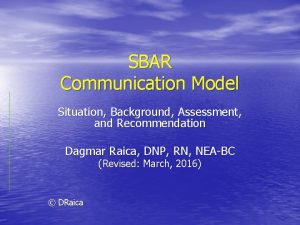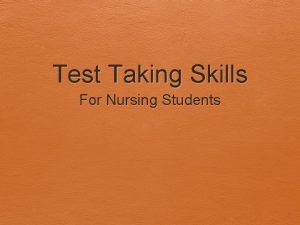Supporting nursing students in prison health placements Associate














![Results: Student perceptions Preceptor issues noted by students “I thoroughly enjoyed [the placement], but Results: Student perceptions Preceptor issues noted by students “I thoroughly enjoyed [the placement], but](https://slidetodoc.com/presentation_image_h2/b38340e5b254e95e5c970853aae4df2b/image-15.jpg)




- Slides: 19



Supporting nursing students in prison health placements Associate Professor Thea van de Mortel, Deputy Head of School (Learning &Teaching) School of Nursing & Midwifery, Griffith University Dr Judith Needham, School of Nursing & Midwifery, Griffith University Ms Kate Barnewall, School of Nursing & Midwifery, Griffith University Ms Ashleigh Djachenko, West Moreton Prison Health Service Ms Jennifer Patrick, School of Nursing & Midwifery, Griffith University Griffith School of Nursing and Midwifery 2016

Background • Placements for 3 rd yr course focusing on: • health promotion, primary health care, social determinants of health • health literacy, cultural safety, safe practice in the community, advanced decision-making skills • Offenders have significant and complex (often chronic) health needs (AIHW, 2015) • Often come from disadvantaged backgrounds • High incidence of mental illness • 27% identify as First Peoples; incarcerated at 13 x rate of general pop’n (ABS, 2015) Griffith School of Nursing and Midwifery 2016

Background (continued) Student nurses: Øcommenced clinical placements in US prisons in 1960’s ØLearn care management for physical and mental disorders, ØLearn multidisciplinary teamwork (Fac Hlth Soc Care & Educ, 2015; Norman, 1999) ØIn Australia, UG student nurse placements occur in privately run and public prisons (Justice Health, 2015; Martin & Happell, 2001) ØGU placing 3 rd yr nursing students in 4 QLD Health metropolitan PHS since March 2014 • Limited info in literature on students’ and preceptors’ experiences of these placements Griffith School of Nursing and Midwifery 2016

Aims • work collaboratively with PHS to investigate and improve the student experience and the engagement of clinical staff in student education • improve clinical education opportunities in the QCETC priority areas of mental health and indigenous health. • provide evidence-based research on clinical placements that may extend the engagement of Prison Health Services (PHS) in clinical education. • develop a set of strategies to support preceptors and students in the PHS setting that can be disseminated to other agencies and settings to increase the educational value of clinical placements. Griffith School of Nursing and Midwifery 2015

Methodology Design & participants • Mixed methods • 3 rd yr student nurses (n= 46) attended PHS in 4 metropolitan prisons (2015) • email invitation to participate in online survey and 30 -min interview. Setting Ø Women’s Correctional 350 prisoners + 20 FTE nursing staff Ø 2 x Male Correctional Centres 600 prisoners + 22 FTE and 700 prisoners + 19 FTE Ø Youth Detention Centre 110 youth + 10 FTE Ethics approval obtained from West Moreton H&HS & Griffith University HRECS. Griffith School of Nursing and Midwifery 2016

Methodology (cont’d) Survey: 48 items • Global rankings of students’ overall perceptions of: • the facility and their preceptor/s (5 -point Likert scale: unacceptable to outstanding) • Students’ perceptions of the strategies used to teach staff and their preceptor/s, how well learning outcomes were met • Open response questions on • what aspects of facility valued most; what was most challenging; suggested areas for improvement • preceptor’s strengths and suggested areas for improvement. Interviews Open-ended questions about students’ opinions and experiences. Griffith School of Nursing and Midwifery 2016

Project Outcomes Student response rate: Ø 18 (39. 1%) completed online survey Øqualitative data from 16 (34. 8%) Griffith School of Nursing and Midwifery 2016

Results: Prison health placement experience On global rating of PHS placement experience, 88. 9% (n=16) perceived the placement was good to outstanding Griffith School of Nursing and Midwifery 2016

Results: Student perceptions Students mostly agreed that the health care facility: • was appropriate to meet the placement objectives (mean 4. 32) • provided learning experiences including critical thinking, client interaction, health assessment and hands-on experience (mean 4. 53) • methods used by the non-preceptor staff created a supportive learning environment (mean 4. 40) “The staff facilitated my learning and supported me and accepted me as if I was a staff member. ” Aspects students most valued: • gaining a range of clinical experiences, practicing skills and practicing autonomously • feeling part of the team • having the opportunity to practice in a different environment • qualities and behaviours of the facility staff including willingness to answer questions, staff helpfulness, approachability and flexibility Griffith School of Nursing and Midwifery 2016

Results: Student perceptions Most challenging: • emotional state of prisoners and how to deal with them • Staff attitudes and behaviours, ie. lack of empathy, swearing, staff conflict • the prison setting - regulated environment, lack of resources, restrictions to care, safety concerns, feeling isolated • nature of the prisoners - developing therapeutic relationships • lack of preparedness – different from a hospital placement, confronting environment, safety and security issues • feeling comfortable with placement in two weeks Griffith School of Nursing and Midwifery 2016

Results: Student perceptions Preceptor effectiveness • 78% of students worked with 1 -4 preceptors; 22% with > 5 • 83. 33% rated their preceptor/s as good or outstanding in terms of teaching effectiveness Griffith School of Nursing and Midwifery 2016

Results: Student perceptions Preceptor qualities noted by students “She was by far the best buddy nurse I've had through my entire degree. ” • highly knowledgeable, keen to share knowledge • professionalism – seen by interactions with students, staff and prisoners • Respectful and empathetic • taking care and pride in work; enjoys the work • being systematic and organized • good role modeling; answering questions and giving feedback in a positive way • mentoring, assisting students’ professional development –support and encouragement, improving confidence, trust and independent practice • encouraging reflective practice Griffith School of Nursing and Midwifery 2016
![Results Student perceptions Preceptor issues noted by students I thoroughly enjoyed the placement but Results: Student perceptions Preceptor issues noted by students “I thoroughly enjoyed [the placement], but](https://slidetodoc.com/presentation_image_h2/b38340e5b254e95e5c970853aae4df2b/image-15.jpg)
Results: Student perceptions Preceptor issues noted by students “I thoroughly enjoyed [the placement], but there are tough people in there to work with and that’s not just the prisoners. ” • • Lack of continuity with preceptor Lack of hands on experience with preceptor (preceptor too busy) Direct or indirect hostility from preceptors Some staff attitudes confronting – lack of student-preceptor engagement “You just work around those nurses who do not want to know about you. ” Griffith School of Nursing and Midwifery 2016

Discussion Students viewed prison placements as a positive experience: vthey achieved their learning objectives vdeveloped counseling skills and gained insights into social determinants of health vprovided care for vulnerable, under-served population v. Results mirror other literature on healthcare students other than nurses (Leamon et al, 2001; Sufrin et al, 2012) Griffith School of Nursing and Midwifery 2016

Recommendations Planning and orientation • Need for detailed orientation to include: - safety aspects, prison policies - psychological preparation (eg. exploration of feelings, expectations of the experience, and awareness of students’ views & stereotypes) • Use of simulation to introduce students to the prison setting - develop critical thinking about complex patients and situations - aid student development of active learning & communication Griffith School of Nursing and Midwifery 2016

Recommendations Refining selection process for students • Podcasts of previous students’ experiences may help know what to expect and whether they are a “good fit” for PHS Preceptor education and support • encourage PHS staff to preceptor same student for a period of time to address lack of continuity and support Griffith School of Nursing and Midwifery 2016

References • Australian Bureau of Statistics. (2015). Prisoners in Australia 2015. Retrieved from Canberra: http: //www. abs. gov. au/ausstats/abs@. nsf/mf/4517. 0 • Australian Institute of Health and Welfare. (2015 a). The health of Australia’s prisoners 2015. Retrieved from http: //www. aihw. gov. au/Work. Area/Download. Asset. aspx? id=60129553682 • Faculty of Health Social Care & Education. (2015). Overview of adult nursing placements Across Essex, Cambridgeshire, Hertfordshire and London: Anglia Ruskin University. • Justice Health and Forensic Mental Health Network. (2015). Student Clinical Placements. Retrieved from http: //journals. rcni. com/doi/pdfplus/10. 7748/ns. 29. 37. 66. s 51 • Leamon, M. H. , Fields, L. , Cox, P. D. , Scott, C. , & Mirassou, M. (2001). Medical students in jail: The psychiatric clerkship in an outpatient correctional setting. Academic Psychiatry, 25(3), 167. • Martin, T. , & Happell, B. (2001). Undergraduate nursing students' views of mental health nursing in the forensic environment. Aust N Z J Ment Health Nurs, 10(2), 116 -125 • Norman, A. (1999). Nursing students should go to jail. Nurs Stand, 14(10), 58. • Sufrin, C. B. , Autry, A. M. , Harris, K. L. , Goldenson, J. , & Steinauer, J. E. (2012). County jail as a novel site for obstetrics and gynecology resident education. J Grad Med Educ, 4(3), 346 -350.
 Effects of multiple placements in foster care
Effects of multiple placements in foster care Effects of multiple placements in foster care
Effects of multiple placements in foster care Near-optimal sensor placements in gaussian processes
Near-optimal sensor placements in gaussian processes Frontier placements
Frontier placements Sonia placements
Sonia placements Renewable energy placements
Renewable energy placements Schuldschein private placements
Schuldschein private placements Lone star college nursing program curriculum
Lone star college nursing program curriculum Rizal involved in student demonstration
Rizal involved in student demonstration Sbar example
Sbar example Test taking strategies for nursing students
Test taking strategies for nursing students Is bcs worth it
Is bcs worth it Promotion from assistant to associate professor
Promotion from assistant to associate professor Tecniche associate al pensiero computazionale
Tecniche associate al pensiero computazionale Inca civilization
Inca civilization Incose asep certification
Incose asep certification Drawback of direct mapping
Drawback of direct mapping Hid cern
Hid cern Associate degree netherlands
Associate degree netherlands Associated consulting engineers
Associated consulting engineers





































